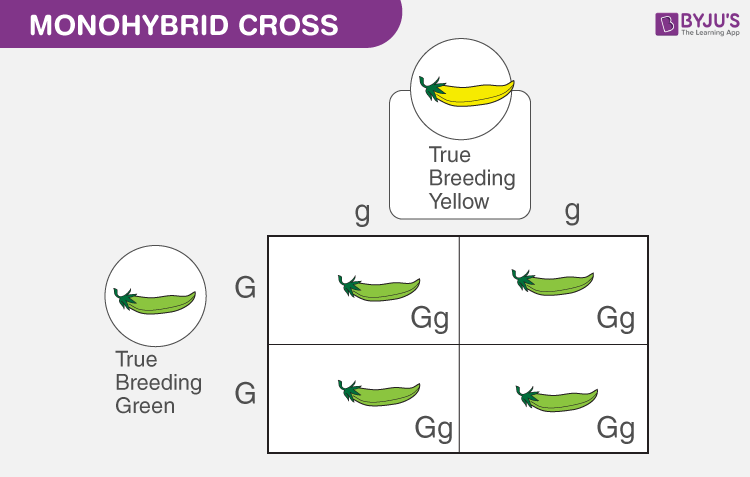Inheritance is the acquiring of genetic characteristics or traits from parents by their offspring.
In the year 1860, Gregor Johann Mendel, the father and founder of genetics unlocked the mystery of genetics. He conducted many experiments on pea plants and observed their pattern of inheritance from one generation to the next generation. His investigation led to the discovery of three laws of inheritance, famously known as Mendel’s Laws of Inheritance.
The Law of Dominance, Law of Segregation and Law of Independent Assortment are the three Mendel’s laws of inheritance. These laws came into existence by the experiments on pea plants in a variety of differing traits. Mendel started his research with monohybrid cross.
Mendel observed that traits which were absent in the F1 generation had reappeared in the F2 generation. These observations led to the formulation of the Law of Dominance and the Law of Segregation.
Also Read: Law of Independent Assortment

In this section, let us take a detailed look at the two laws of inheritance, namely, Law of dominance and Law of segregation.
Law of Dominance
Mendel’s law of dominance states that:
“When parents with pure, contrasting traits are crossed together, only one form of trait appears in the next generation. The hybrid offsprings will exhibit only the dominant trait in the phenotype.”
Law of dominance is known as the first law of inheritance. In this law, each character is controlled by distinct units called factors, which occur in pairs. If the pairs are heterozygous, one will always dominate the other.
Law of dominance explains that in a monohybrid cross between a pair of contrasting traits, only one parental character will be expressed in the F1 generation and both parental characters will be expressed in the F2 generation in the ratio 3:1.
The one which is expressed in the F1 generation is called the dominant trait and the one which is suppressed is called a recessive trait. In simple words, the law of dominance states that recessive traits are always dominated or masked by the dominant trait. This law can be described by Mendel’s experiment.
A monohybrid cross is a cross between the two monohybrid traits (TT and tt). Here plants which have the same characters, but differ in only one character were crossed.
For monohybrid cross, Mendel began with a pair of pea plants with two contrasting traits, i.e., one tall and another dwarf. The cross-pollination of tall and dwarf plants resulted in tall plants and the offspring were called F1 progeny. The trait which is expressed in the phenotype is called the dominant trait while the one that is not is called the recessive trait.
He then continued his experiment with self-pollination of F1 progeny plants. This resulted in both tall and short plants in the ratio of 3:1 which gave rise to the law of segregation.
Law of Segregation
Mendel’s law of segregation states that:
“During the formation of gamete, each gene separates from each other so that each gamete carries only one allele for each gene.”
Law of segregation is the second law of inheritance. This law explains that the pair of alleles segregate from each other during meiosis cell division (gamete formation) so that only one allele will be present in each gamete.
In a monohybrid cross, both the alleles are expressed in the F2 generation without any blending. Thus, the law of segregation is based on the fact that each gamete contains only one allele.
This law is based on four basic concepts:
- A gene exists in more than one form of an allele.
- When gametes are produced by meiosis, the allelic pairs separate, leaving each gamete with a single allele.
- Every organism inherits two alleles for each trait.
- The two alleles of a pair are different, i.e., one is dominant and one is recessive.
Also Read: Mendelian Genetics
For more information on the law of segregation and law of dominance, keep visiting BYJU’S website or download the BYJU’S app for further reference.

Frequently Asked Questions
What does the law of dominance state?
The law of dominance states that one of the pairs of inherited traits will be dominant and the others recessive unless both the factors are recessive.
What is the law of segregation?
The law of segregation states that the alleles of a given locus segregate into separate gametes.
Give an example of the law of dominance.
Parents that are pure for contrasting characters are crossed, only one form of the trait will appear the dominant trait appeared in the next generation. This best explains the law of dominance.
What are Mendel’s three laws?
Mendel stated three laws known as Mendel’s laws of inheritance. These laws are:
- Law of Segregation
- Law of Dominance
- Law of Independent Assortment
What are the limitations of the law of segregation?
Law of segregation applies only to traits that completely control a single gene pair in which one of the two alleles is overriding the other. Therefore, the law of segregation does not apply to incompletely dominant or co-dominant alleles.

Why law of segregation is also called as law of purity of gametes
The gametes which are formed are always pure for a particular character. A gamete may carry either the dominant or the recessive factor but not both as we find in F1 individuals.
Very helpful theory thank you
yeah really very helpful
Nice explanation
First time getting all the information I need on one website. This is really helpful, thanks a lot.